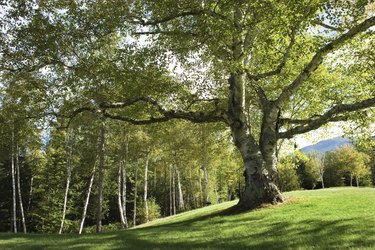
Trees are essential to human existence, because they produce oxygen, cleanse the air, provide shade, clean the soil and control noise pollution. The growth of trees begins with a single seed that must compete with others for water, nutrients and space to grow. Not many seeds reach all four stages of tree growth; many are destroyed by insects or disease before reaching maturity.
Seedling
Video of the Day
The seedling represents the first stage in tree growth; this stage begins once the tree seed is put into the ground. The seedling begins to grow as it receives the proper sunlight and adequate water. As the tree begins to sprout, it is weak and much of its energy is spent growing deeper roots and thicker stems. During this stage, parts of the tree begin to develop, including the parts that carry sap and nutrients and grow bark.
Video of the Day
Primary Growth
Primary growth is the second stage of tree growth and is the transitional period during which the plant begins to mature and the root system expands. During this stage, branches begin to develop and leaves start to form. While leaves vary in size depending on the tree, the bark on the tree is still very immature.
Secondary Growth
Secondary growth is the third stage of tree growth and results in the increase of trunk diameter. The branches become longer and stronger, and the tree fills out with twigs and leaves. In the ground, the roots begin to spread out to provide the tree with a more firm and solid base. This is the final stage before a tree reaches full maturity.
Maturity
Maturity is the final phase in tree growth and is the time when substantial bark develops and, in some cases, when the fruit cycle begins. Another sign of maturity is when the tree begins to produce seeds for reproduction. The energy of the tree focuses on reproduction during this stage, and the tree reaches its full size. Growth begins to spread more outward than upward at this point. Another sign of maturity is when the trunk reaches 1 foot in diameter.